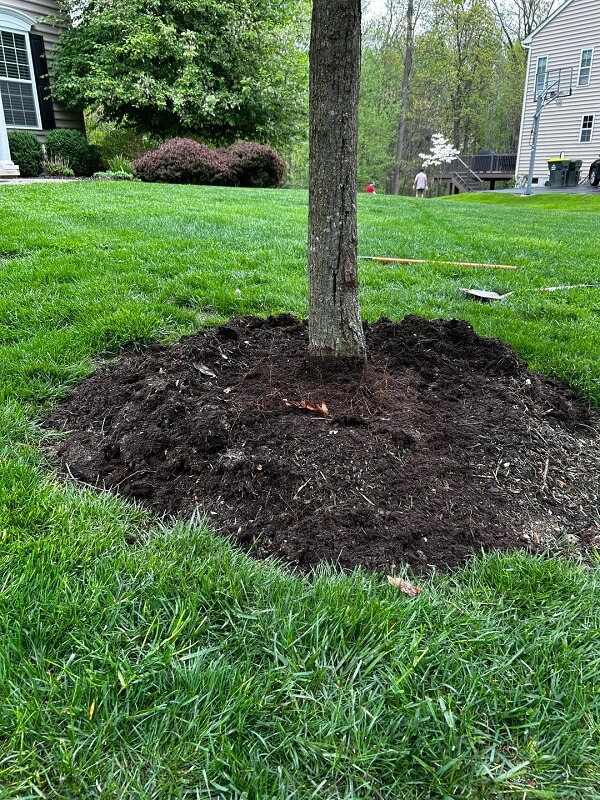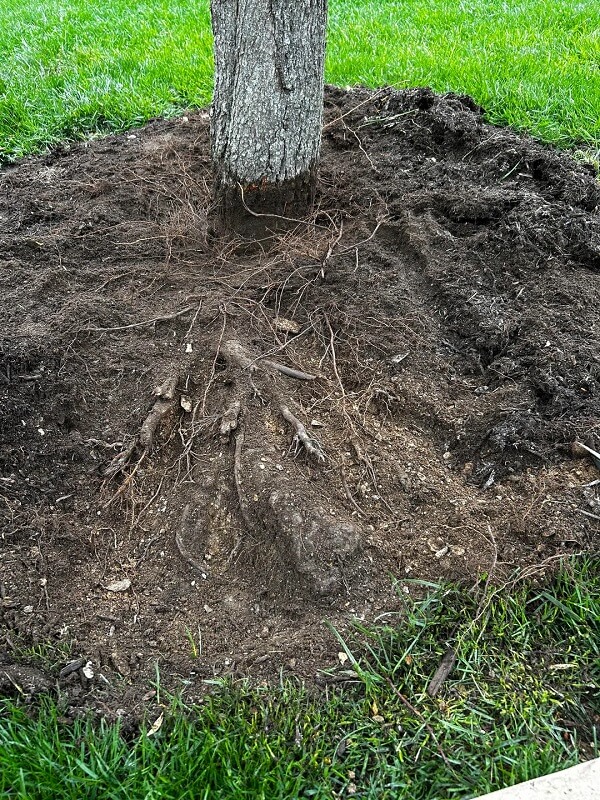A common mistake that some homeowners and landscapers make when mulching trees is accidentally burying the tree's base in a mound, known as "mulch volcanoes," which can cause a host of root and bark issues.
Discovering a mulch volcano on one of their trees' bases, one homeowner sought advice from the r/landscaping subreddit on how best to remove the volcano mound to protect the tree.


"The mulch volcano is 8" above ground level," the OP described, sharing pictures of the buried tree trunk. "Started to dig away with a trowel and found large roots at about ground level. Should I continue to take all the mulch and dirt away and just mulch over the roots?"
One user responded, commenting that the tree was potentially poorly planted: "I'm no tree expert but I definitely don't think you want to expose the roots at all! Almost looks like it wasn't planted deep enough."
There are risks associated with over-mulching and under-mulching trees.
Burying the tree's trunk in too much mulch risks suffocating the tree, as the root flare is where the oxygen exchange happens. Mulch volcanoes also act as sponges, absorbing and retaining water to keep the soil moist. However, this absorbent quality in mulch volcanoes concentrates a lot of moisture at the tree's trunk, which could lead to rotting and eventually death.
Save $10,000 on solar panels without even sharing your phone number Want to go solar but not sure who to trust? EnergySage has your back with free and transparent quotes from fully vetted providers that can help you save as much as $10k on installation. To get started, just answer a few questions about your home — no phone number required. Within a day or two, EnergySage will email you the best local options for your needs, and their expert advisers can help you compare quotes and pick a winner. |
Under-mulching a tree also risks leaving the tree's roots and lower levels of soil partially exposed, which could lead to drying out, poor water retention, and increased weed growth.
The North Carolina Urban Forest Council recommends mulching trees properly to encourage healthier and stronger growing plants. Mulch should only be about two to three inches deep around the tree — extending to the tree's dripline — making sure to keep one to two inches around the tree trunk clear for oxygen exchange.
If possible, keep the mulch organic and free from dyes. Dyed mulch removes nutrients from the soil and can harm young plants that were recently landscaped.
Poor mulching practices disturb your lawn's soil ecosystem, but so do invasive grass species, which happen to make up a large majority of American lawns.
TCD Picks » Upway Spotlight
💡Upway makes it easy to find discounts of up to 60% on premium e-bike brands
|
What's the hardest thing about taking care of your yard? Click your choice to see results and speak your mind. |
Invasive grasses like Kentucky Bluegrass grow quickly and, compared to native plant species, require more water to keep green, which forces homeowners to mow more often and use more water.
Upgrading to a native plant lawn, which consists of native plant species already acclimated to the local climate and deeply intertwined in the local ecosystem, can help homeowners save time and money on lawn maintenance and water bills. These native plants also attract important pollinators to your garden, which play an important role in plant reproduction and increased crop yields.
Buffalo grass, which is slow-growing and drought-resistant, is an alternative lawn replacement option that may comply with regulations by homeowner associations as it most closely resembles traditional grass turfs. Those not limited to HOA rules may find clover another suitable lawn replacement option, as clover is cheap to install, drought-resistant, and lush year-round.
"Oh my god, that tree is buried. You have the right idea. That root flare needs to be exposed," one commenter wrote.
Join our free newsletter for easy tips to save more and waste less, and don't miss this cool list of easy ways to help yourself while helping the planet.








